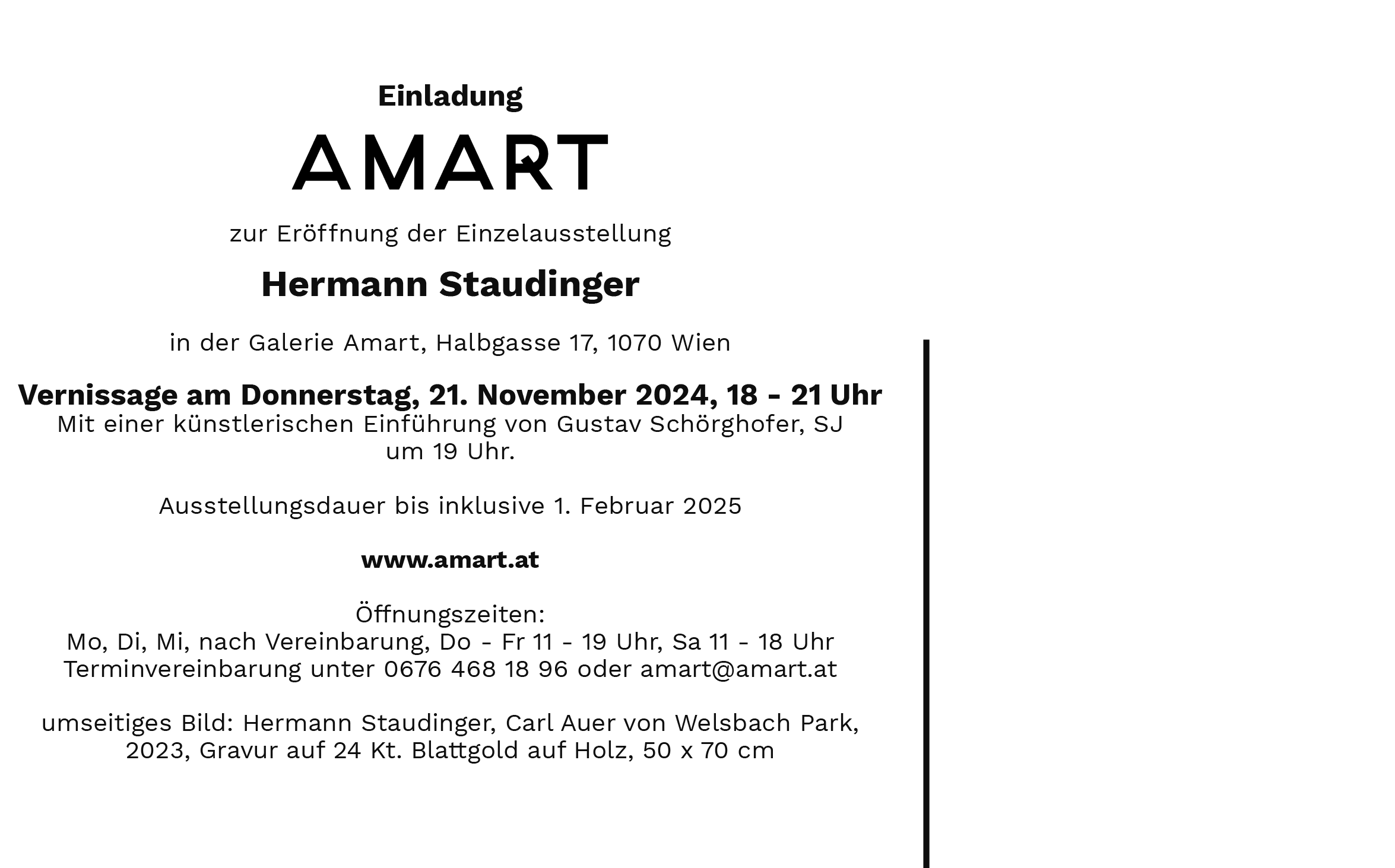Shadow and Gleam
Some Remarks on the Art of Hermann Staudinger
A defining feature of Hermann Staudinger's art is the consistent use of gold, specifically gold leaf of various alloys. Initially, objects were gilded, but later, surfaces became the focus, treated differently as image carriers. There are gilded surfaces serving as backgrounds for digital prints on Plexiglas. Alternatively, the digital print can be applied directly to the gilded surface itself. Then there are the works referred to as "engravings, or embossings" which involve stretching a sheet of paper with the copy of the subject over a gilded softwood surface. With a hard pencil, hatching is drawn closely together, pressing the subject into the soft ground. The areas exposed to the print become matte, resembling the negative of a photograph, while the landscape depicted on the template glimmers in gold. The subjects in Hermann Staudinger's works are typically landscapes or architectures, with rare representations of figures. The emphasis appears less on the depicted subject itself than on a unique form of the appearance of the visible. Related to the engravings are those works consisting of a gilded surface that has been rubbed away. Where the sheets of gold overlap, the gold remains; elsewhere, the base becomes visible. The gold lies over the surface of the base like a shimmering net.
In the art of Europe, gold has played a multifaceted role. In Late Antiquity, the gilded picture ground already exists, gaining great significance in medieval art from the early 10th century onward. It is understood spatially, as a kind of spatial foundation for the figures. The gold, with its luster, expands the surface into the spatial realm. In the late Middle Ages, this indefinite space is reinterpreted as a landscape space. If we understand the artwork as an autonomous creation of a named individual, then art emerges in the 14th century. Giotto can be regarded as its ancestor to some extent, as he is credited with the construction of independent and self-contained images. Notably, Giotto opens Vasari's artist biographies. In Giotto's frescoes, the gold ground is replaced by monochromatic blue. From the 15th century onward, the significance of gold in the image diminishes. Gold migrates into the frames, into parts of the architecture, and into highlights.
Figures are gilded, but the gold of the spatial background has been lost. Now the shapes emerge from a chiaroscuro environment. And when the spaces of the Baroque can be experienced in darkness, it becomes evident that the gold, with its ability to reflect even the tiniest light impulses, creates a kind of light architecture, a space in which a strange responsiveness can be experienced from the darkness.
With the departure from representation and the turning towards material in its autonomous effect, gold is rediscovered in modernity. Often, it carries the aura of the sacred, of the extremely precious. Accordingly, gold is used to give people or objects a special radiance. This also makes the use of this powerful metal suspicious. Spectacle quickly takes precedence while artistic design falls by the wayside. A major exhibition at the Belvedere, curated by Thomas Zaunschirm, gathered a wealth of examples of gold use in art in 2012. At that time, the use of gold in art since the 19th century was very well documented. Works by Hermann Staudinger were featured in this comprehensive show.
Over the years, Hermann Staudinger has developed an independent position in his handling of gold. This is most evident in the "Engravings." The characteristic features of an artist's handwriting are almost entirely erased in them. Here, no virtuosic image creation is staged. Rather, the emergence of the images has something very meditative, yet also demands intense physical effort. For the hours spent laying down hatching is strenuous; it requires strength and endurance. What emerges is, in a sense, a relief. The pressure of the pencil slightly indents the surface of the wooden plate. The shimmering gold becomes matte in the depressions. Like a shadow, the world depicted on the template appears in the glow of the remaining and unworked gold surface. Visible reality emerges as a monotonous dimming. At the same time, the whole operates as a piece of the world carried and breathed by the luster of gold, a space filled with light. Hermann Staudinger thus succeeds in elevating the everyday and the unspectacular to the realm of the wonderful.
Something similar occurs when images printed on Plexiglass are mounted a short distance in front of a gilded surface. The image casts shadows on the luminous area, while the gilded surface backlights the depicted subject. The landscapes and architectural details, steps, or windows printed on the gold surface can be spectacular. The gold appears as an intense light source or imbues the objects with a shimmer that alleviates their heaviness. These works require great discipline in handling the material's possibilities, in a sense a form of fasting in the use of powerful means. This willingness to fast is also reflected in the gilded and abraded surfaces, the "gold walls." It hinges on pausing at the right moment, precisely when the sober base and remnants of the precious material hover in suspension.
Hermann Staudinger has succeeded in his persistent and long-term work to create an art form that combines the magic of life's simple things with the enchantment of a unique material, gold. He intertwines the two so that one magic permeates the other, making both the fleetingness of this world and its ever-renewing approach and awakening present in shadow and illumination.
Gustav Schörghofer SJ
